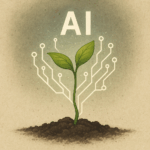OMGAP is my creation. Don’t look for the meaning of this acronym on the Internet; there’s very little chance you’ll find its explanation there. OMGAP is the new GAFAM (Google, Amazon, Facebook, Apple & Microsoft); it’s “OpenAI, Meta, Google, Anthropic & Perplexity.” Yes, exactly in the same style.
Because today, we are witnessing a shift in the center of gravity of IT technology power toward AI. This AI is best represented by the five companies cited in this new acronym. Because AI is now the technology that drives not only the IT world and its investments but also the entirety of business life and our personal lives.
Present everywhere, AI now plays an important, if not major, role in market segments such as creation (images, videos, games, etc.), banking and insurance, healthcare, agriculture, heavy industry (assembly lines, etc.), the judicial world, public services, advanced research… and I’m forgetting many others.
These OMGAP companies (feel free to reorder the letters to get a more amusing or sexy acronym :-)), you’ve recognized them all; they are the major players in AI, almost all of them living only from AI and for AI! Unless you’ve been living on an isolated island (but does that still exist?) for the past 2 or 3 years, it’s impossible that you haven’t heard of them.
As I wrote before, with AI being present everywhere today, these companies and a few others are redefining not only business life but also life itself, our personal life.
These new tech leaders, these AI masters, not only dominate the market but also impose their economic model and technical strategy on it. In just a few months, companies find themselves locked again into vendor strategies over which they have no leverage.
Then came DeepSeek.
A Chinese company, certainly, thus originating from a country that everyone rightfully distrusts, as a simple security principle. But a company that pushes a model primarily focused on OpenSource. DeepSeek’s LLM is available on HuggingFace, the reference platform for sharing OpenSource AI technology. Other companies controlled by Beijing have followed suit.
This leads me to make a comparison that some might find daring, but let’s dare!
DeepSeek, already noted for its disruption at other levels, is pushing and promoting OpenSource AI. That it’s Chinese does not diminish the significance of this assertion. The counterpower to the AI giants is there, and again, it lies in OpenSource.
Just as nearly 35 years ago, an event barely glimpsed by the specialists of the time would revolutionize computing as it was conceived then, that is, by paying—sometimes very dearly—for licenses to Microsoft or IBM. This event was the public release of a very first version of an entirely OpenSource Unix kernel (under GNU GPL license) by a young Finnish student named Linus Torvalds. This kernel, combined with GNU utilities and software, quickly became a serious alternative to the dominant Microsoft, SUN, or even a few other Unix-type OS vendors.
Today, Linux is by far one of the most used OS in businesses. Even if it’s no longer truly free as it was at the beginning, it still benefits from the feedback of the OpenSource community whose software is still found there. Different companies have emerged (Red Hat, Canonical, …) offering “Linux distributions,” that is, a compilation of OpenSource software, with home-grown tools and a subscription to obtain commercial support.
We will observe with great interest the evolution around OpenSource projects in AI. Because today it is still too early to say if “the Deepseek moment” we have just experienced is equivalent to August 25, 1991, the date Linus Torvalds announced the development of the Linux kernel.
Because the complete availability of all code, scripts, and training data allows for more extensive collaboration between “freak” developers, university researchers, and commercial actors. This will create a new dynamic around LLMs, undoubtedly reduce certain costs, and thereby diminish the grip of the commercial actors mentioned at the beginning of this article. DeepSeek, a Chinese company unknown just a few months ago, may have become the Linus Torvalds of AI.
But only time will tell. Because in 1991, who could have predicted the enthusiasm and use that the Linux kernel would have after just a few years!

